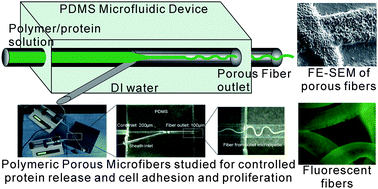This paper shows successful fabrication of different diameter porous microfibers using a novel, simple and cost effective polydimethylsiloxane (PDMS)-based microfluidic device in which an amphiphilic ABA triblock copolymer, poly(p-dioxanone-co-caprolactone)-block-poly(ethylene oxide)-block-poly(p-dioxanone-co-caprolactone) (PPDO-co-PCL-b-PEG-b- PPDO-co-PCL) in dichloromethane (CH2Cl2), and de-ionized water (DI H2O) were taken in two inlets to extrude porous fibers through the outlet utilizing a dual mechanism of immersion precipitation and solvent evaporation. The flow rates of the two inlet solutions (core and sheath) were controlled such that 5–50 μl min−1 and 100 ml h−1 were used, respectively, to produce 2–200 μm diameter porous microfibers. Controlled fibronectin (an adhesive protein) release from the scaffold was observed until 8 weeks in an in vitro protein release study, which could be due to the slower scaffold PCL block degradation rate until 8 weeks of the in vitro degradation analysis. Cytocompatibility of our porous scaffold was demonstrated for its applicability as a cell culture scaffold or implant material by means of analysis of surface hydrophilicity (water and cell suspension contact angles) and mitochondrial activity (WST-1 proliferation test) using L929 mouse fibroblasts cell line. In summary, the experimental results suggest that combined use of the microfluidic device and amphiphilic triblock copolymer produces varied diameter porous fiber scaffolds which can be potentially used as a controlled protein/drug release carrier for tissue regeneration and/or drug delivery applications.

You have access to this article
 Please wait while we load your content...
Something went wrong. Try again?
Please wait while we load your content...
Something went wrong. Try again?


 Please wait while we load your content...
Please wait while we load your content...